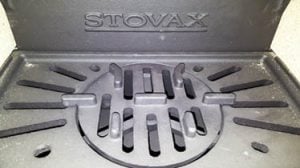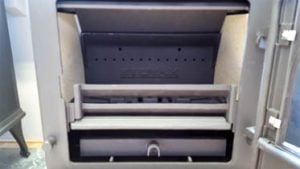For this blog, let’s take a closer look at the Stockton 5 wood burning and multifuel stoves from manufacturer Stovax Ltd.
Originally brought to the market in July 2006, The Stovax Stockton 5 became an instant hit. Due to its clean styling and its high efficiency levels, this stove is suited to almost any room setting.
A “Mark 2” version of the Stovax Stockton 5 was released in August 2012 with some small but impressive changes. These were made to keep up with new technological improvements. Such improvements included a better external riddling system for the multifuel grate, improved door handle mechanism and door hinges, and an accessible “Tertiary” air slider situated underneath the stove. The Tertiary air control is useful for both the initial lighting of the stove and to raise to the recommended running temperature.
The Stockton 5 is available as either a wood burning or multifuel (smokeless coal & wood) stove. The main difference between the two versions is that the Multifuel stove features a cast iron grate and steel ashpan. This grate is to allow air to pass through underneath the coal to stoke the fire and keep the fuel burning well. In addition, the ashpan helps with cleaning the stove out due to extra ash produced by smokeless coal.
The wood burning only model is void of any grate or ashpan and is designed instead to allow the maximum amount of logs to be loaded within (See image comparison below).
Complete Control
An impressive feature of the Stovax Stockton 5 is the controllability. An Airwash control slider is fitted onto the front door of the stove. An additional Secondary or “Tertiary” air control lever is tucked underneath.



The primary air control lever is positioned towards the bottom of the door just under the glass. This control draws in air through a vent and up through the grate in the multifuel version to stoke the coals or logs. Furthermore, in the wood only version, it forces air straight into and around the logs to feed the fire with oxygen and increase the heat produced.
Keep the glass panel clean with the airwash slider control. The Stockton 5 airwash incorporates a “boost” setting. This additional feature increases the amount of air flow applied through the vent and directly on to the glass.
Finally, the Secondary air lever (positioned underneath the stove) is operated by positioning back and forth. Pulling this lever toward you opens up a large vent on the underside of the stove which increases the flow of air into the inner firebox. This setting is excellent in aiding both the initial lighting of the stove and in bringing the stove up to the required optimum burning temperature.
Multifuel Riddling Grate
Another important feature with the Stockton 5 multifuel version is the external riddling system. This system consists of a solid tubular bar that protrudes through inside the stove chamber connecting to the multifuel grate.
The inner multifuel grate consists of two parts: an outer fixed square piece and a smaller round section that connects to the stoves riddling arm. When operated from the outside, the riddling arm causes the inner round grate section to rotate back and forth. This motion moves the logs or coal and knocks off a layer of ash to expose the red hot fuel beneath.


Cleanburn
The Stockton 5 contains a “Cleanburn Chamber” to the rear of the firebox. This impressive kit draws air into the stove through a series of small holes. As the air enters the firebox, it swirls to create a vortex effect within the burner. This in turn helps to burn off gases that would otherwise be sent straight up the chimney. This affect improves the efficiency and cleanliness of the stove.
Wood Burning
Purchase the Stockton 5 as a wood burning or “multifuel” version. The multifuel allows use of both wood and smokeless coal.
Customers often ask us which of the two options available is the best. The honest answer is it depends on what you value the most from your stove. It may seem obvious to most that if you plan to only ever burn logs, then the wood burning only version is the way for you. And of course, vice versa should you intend to burn either a mixture of logs and coal, or just purely coal on its own, then the multifuel version is a must. However it might not be quite that simple.


The wood burning only variant does not include a grate and ash pan which means that you have the maximum amount of space within your firebox. This being the case, you have the freedom to burn larger logs. You will find that, when used properly, the stove will burn your well-seasoned logs down to a very minimal amount of ash. This is opposed to the large amount of ash left over after burning smokeless coal.
With the wood burning stove you are left with a pile of ash you must remove. Unless you invest in a specialist vacuum cleaner for the task, such as the “Ash-Vac”, you will need to do this by hand. This can be both messy and time consuming.
Multifuel
Should you instead opt for the multifuel version of the Stockton 5 stove, you will then receive both an ashpan and multifuel grate packaged within the stove as standard. This grate and pan system make life very easy when it comes to cleaning. This process involves merely brushing the ash through from the top of the grate down into the pan. Do this once burning has finished and the ashes are cooled.
The multifuel grate reduces the inner firebox chamber size. This means a slight restriction on the amount of logs used at one time.
Defra Approval
When located within a “Smoke Controlled Area” you must ensure your wood burning or multifuel stove is Defra approved. Both versions of the Stovax Stockton 5 are manufactured as such.
In Conclusion
We hope that the information above is of some help to anyone contemplating purchasing this fantastic stove. Should anyone have any questions that we have not answered in this review, please contact us at [email protected] .
Find the full range of Stovax on our website here.
In the next blog we will be discussing the Stovax Professional XQ twin wall flue system. Used when no conventional chimney stack is present. These stainless steel flue systems have proven increasing popular in recent years with more modern houses and apartments.





